City contours Göttingen
The knowledge city with an innovative spirit
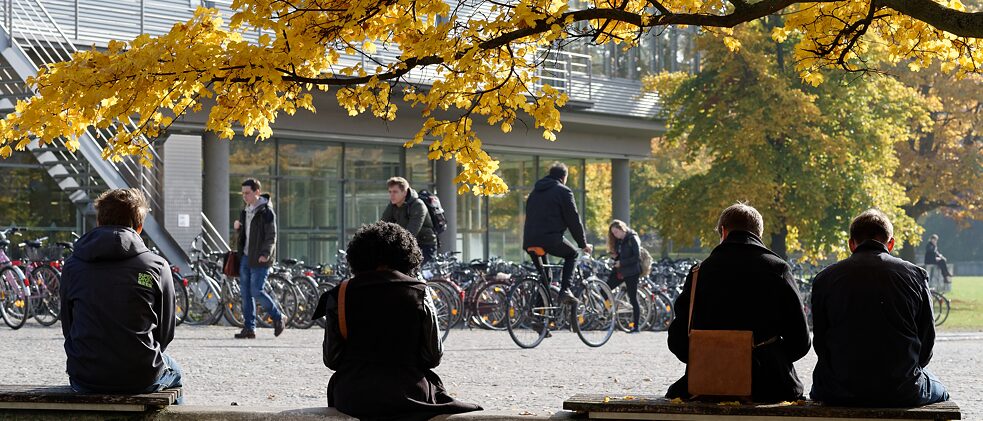
In Göttingen, all roads lead to the university, with every fourth resident being a higher education student.
|
Photo (detail): © picture alliance/dpa/Swen Pförtner
Göttingen’s motto “The city that creates knowledge” is emblazoned on the central train station where it welcomes newcomers and long-time residents alike. It could hardly be more fitting, given that Göttingen University sets the pace and rhythm of the city. Our author Stefan Keitel takes us on a tour of places full of academic free spirit, industrious research and political resistance.
By Stefan Keitel
Innovative spirit in the knowledge city
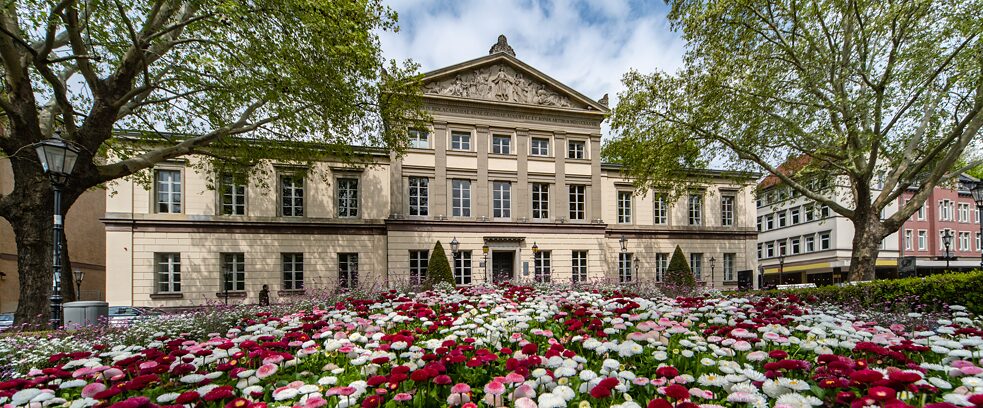 The historic auditorium building at Georg August Universität in Gottingen’s downtown district.
| Photo (detail): © Adobe
Here’s a question for the next pub quiz: what do recycled paper, cocaine, lightning rods and edible bowls for chips have in common? You’ve probably guessed it: They were all invented in the city of Gottingen in southern Saxony. This university city is very proud of the many advances and inventions it has given the world over the years. It has been home to over 40 Nobel Prize laureates, 14 of whom received the honour for discoveries they made in Gottingen. But Gottingen scholars were making a name for themselves long before the Nobel Prize even existed: Otto von Bismarck, the Brothers Grimm, Carl Friedrich Gauss and Max Planck all lived, worked and conducted research here. All roads lead to the university here, with every fourth resident being a higher education student and Georg August Universität being the second largest employer in the city. Since it was founded in 1737, its buildings have shaped the historic cityscape while its students have put their stamp on the flair and cultural life of the city. Research and invention are by no means limited to the university either, as Gottingen is also home to two universities of applied sciences, some Max Planck Institute branches and the Fraunhofer Institute and German Aerospace Centre are also represented.
The historic auditorium building at Georg August Universität in Gottingen’s downtown district.
| Photo (detail): © Adobe
Here’s a question for the next pub quiz: what do recycled paper, cocaine, lightning rods and edible bowls for chips have in common? You’ve probably guessed it: They were all invented in the city of Gottingen in southern Saxony. This university city is very proud of the many advances and inventions it has given the world over the years. It has been home to over 40 Nobel Prize laureates, 14 of whom received the honour for discoveries they made in Gottingen. But Gottingen scholars were making a name for themselves long before the Nobel Prize even existed: Otto von Bismarck, the Brothers Grimm, Carl Friedrich Gauss and Max Planck all lived, worked and conducted research here. All roads lead to the university here, with every fourth resident being a higher education student and Georg August Universität being the second largest employer in the city. Since it was founded in 1737, its buildings have shaped the historic cityscape while its students have put their stamp on the flair and cultural life of the city. Research and invention are by no means limited to the university either, as Gottingen is also home to two universities of applied sciences, some Max Planck Institute branches and the Fraunhofer Institute and German Aerospace Centre are also represented.
A kiss for the Goose Girl
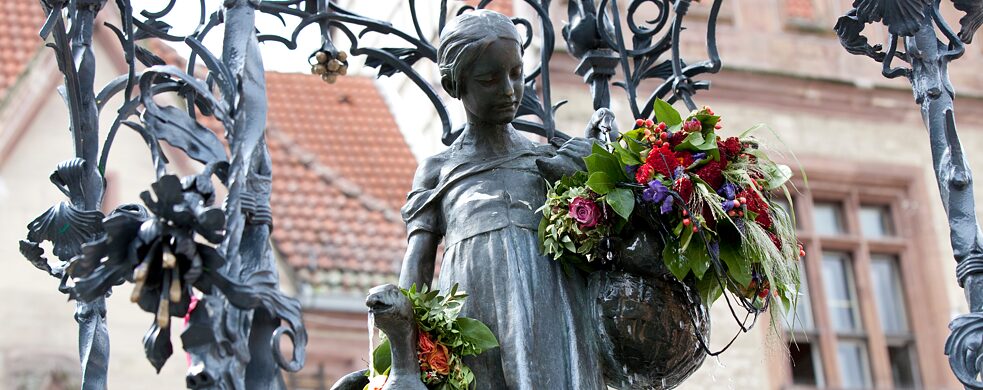 Though it was outlawed for quite a time, no successful doctoral student would leave the city before planting a kiss on the Goose Girl’s cheek and pressing a bouquet of flowers into her hand.
| Photo (detail): © picture alliance/Christian Ender
The square in front of the Old Town Hall is the heart the historic downtown district and a popular meeting place. Though no one would ever suggest meeting up “at the Old Town Hall” or “at the marketplace”, since everyone knows the Gänseliesl or “Goose Lizzy” Fountain is the place to wait on your friends. In the past, tradition demanded that newly enrolled students climb the fountain to give the Goose Girl a kiss. Today only doctoral candidates who have successfully defended their dissertations make the pilgrimage to the Gänseliesl to place a bouquet of flowers in the young maid’s arms and give her a peck on the cheek as friends and relatives look on. By 1926, this custom was causing such large crowds around the fountain that kissing the Goose Girl was outlawed. Even if most ignored the prohibition, it was on the books until kissing was allowed again in 2001. Many people do not know that the current Gänseliesl on the fountain is a copy. The original was moved to Gottingen Town Museum in 1990.
Though it was outlawed for quite a time, no successful doctoral student would leave the city before planting a kiss on the Goose Girl’s cheek and pressing a bouquet of flowers into her hand.
| Photo (detail): © picture alliance/Christian Ender
The square in front of the Old Town Hall is the heart the historic downtown district and a popular meeting place. Though no one would ever suggest meeting up “at the Old Town Hall” or “at the marketplace”, since everyone knows the Gänseliesl or “Goose Lizzy” Fountain is the place to wait on your friends. In the past, tradition demanded that newly enrolled students climb the fountain to give the Goose Girl a kiss. Today only doctoral candidates who have successfully defended their dissertations make the pilgrimage to the Gänseliesl to place a bouquet of flowers in the young maid’s arms and give her a peck on the cheek as friends and relatives look on. By 1926, this custom was causing such large crowds around the fountain that kissing the Goose Girl was outlawed. Even if most ignored the prohibition, it was on the books until kissing was allowed again in 2001. Many people do not know that the current Gänseliesl on the fountain is a copy. The original was moved to Gottingen Town Museum in 1990.
The Göttingen Seven
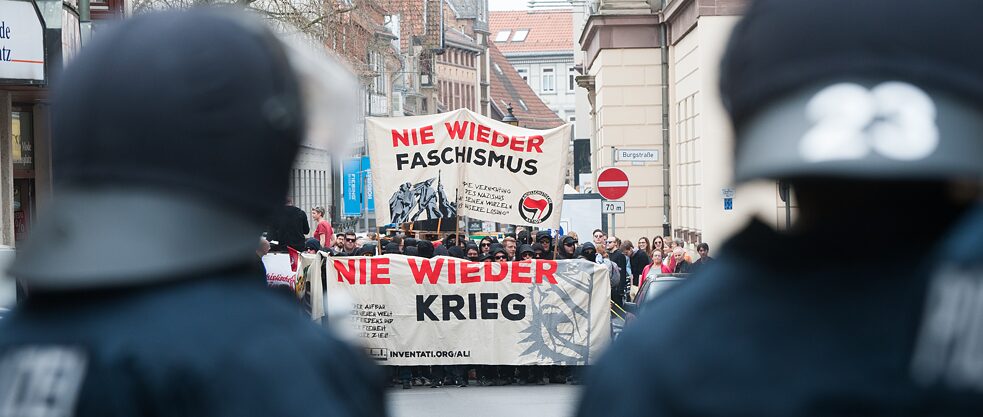 Counterdemonstration at a demonstration of the right-wing extremist “Freundeskreis Thüringen-Niedersachsen” (Thügida) group at Wilhelms Square in Gottingen on April 1, 2017.
| Photo (detail): © picture alliance/dpa/Swen Pförtner
Politically, Gottingen has always been an exciting place. As early as 1837, the “Gottingen Seven”, all professors at the University of Gottingen, protested Ernst August the First of Hanover’s repeal of the liberal constitution in 1833. All seven professors – who included the Brothers Grimm of later worldwide fairly-tale fame – were immediately dismissed and three were even banished from the kingdom. The main station forecourt holds a memorial to this time in the style of the equestrian monument to honour the former king in the station forecourt of Hanover’s central station. Only in Gottingen, there is no horse and no regal rider. The inscription in Hanover reads: “To the father of the country/His loyal people,” while in Gottingen the empty pedestal is engraved “To the father of the country/His Gottingen Seven”. Author Gunter Grass and publisher Gerhard Steidl commissioned another memorial, a sculpture in the Seven’s honour, on the university campus. In the 1980s, Gottingen was a stronghold of Germany’s left-wing autonomous scene. This was taken as a call to action not just by the police and Germany’s domestic intelligence service, the Bundesamt für Verfassungsschutz, but also by the far-right extremists also active in the region. This frequently led to violent clashes. Gottingen still has an active left-wing scene and far-right radical groups regularly organise demonstrations, which are met by counterdemonstrations. These political machinations may be a thorn in the side of some, but it also gives the city its charm. There are still a few occupied houses in Gottingen too, by the way, though the squatter era of the 1980s is long past.
Counterdemonstration at a demonstration of the right-wing extremist “Freundeskreis Thüringen-Niedersachsen” (Thügida) group at Wilhelms Square in Gottingen on April 1, 2017.
| Photo (detail): © picture alliance/dpa/Swen Pförtner
Politically, Gottingen has always been an exciting place. As early as 1837, the “Gottingen Seven”, all professors at the University of Gottingen, protested Ernst August the First of Hanover’s repeal of the liberal constitution in 1833. All seven professors – who included the Brothers Grimm of later worldwide fairly-tale fame – were immediately dismissed and three were even banished from the kingdom. The main station forecourt holds a memorial to this time in the style of the equestrian monument to honour the former king in the station forecourt of Hanover’s central station. Only in Gottingen, there is no horse and no regal rider. The inscription in Hanover reads: “To the father of the country/His loyal people,” while in Gottingen the empty pedestal is engraved “To the father of the country/His Gottingen Seven”. Author Gunter Grass and publisher Gerhard Steidl commissioned another memorial, a sculpture in the Seven’s honour, on the university campus. In the 1980s, Gottingen was a stronghold of Germany’s left-wing autonomous scene. This was taken as a call to action not just by the police and Germany’s domestic intelligence service, the Bundesamt für Verfassungsschutz, but also by the far-right extremists also active in the region. This frequently led to violent clashes. Gottingen still has an active left-wing scene and far-right radical groups regularly organise demonstrations, which are met by counterdemonstrations. These political machinations may be a thorn in the side of some, but it also gives the city its charm. There are still a few occupied houses in Gottingen too, by the way, though the squatter era of the 1980s is long past.
Celebrating in keeping with the university calendar
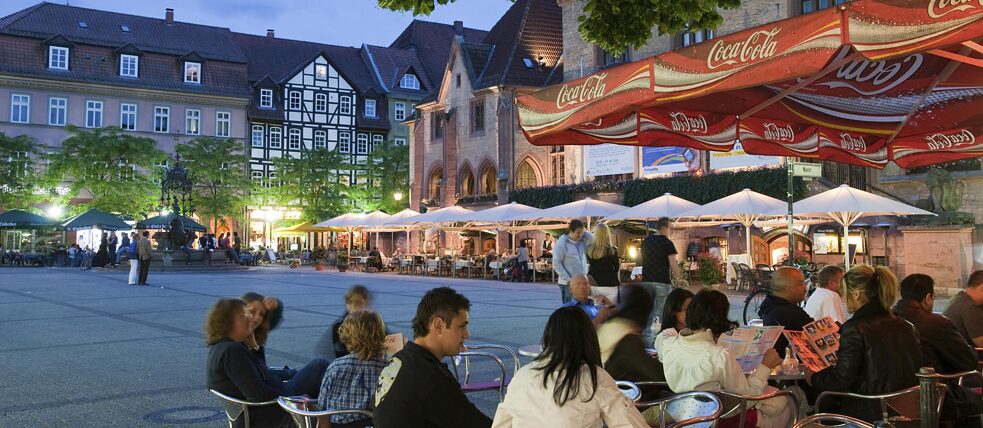 Göttingen’s pulse beats in time to the university semesters, which is particularly noticeable at night: Market square and Old Town Hall in the evening.
| Photo (detail): ©picture alliance/imageBROKER/Ernst Wrba
Gottingen’s pulse beats in time to the university semesters, which is particularly noticeable at night. During the quiet semester breaks, the picturesque old town is a peaceful spot. For at least two weeks a year though, during orientation at beginning of the semester, it is transformed into one large, loud party. The Faculty of the Economic Sciences holds their famous ZHG party – ZHG stands for Zentrales Hörsaalgebäude or the central lecture hall building – self-proclaimed as “Northern Germany’s largest student party”. But during the semester too, the many small bars and pubs are usually full and there are plenty of opportunities to chat over a glass of vino or dance the night away. Slightly off the beaten path, Dots in the Börner quarter offers live music and sets up an open-air stage in summer. Additionally, every Wednesday is traditionally Weizentag or wheat beer day at Thanners, and pretty much every evening on the adjacent Wilhelms Square. If you unexpectedly find yourself peckish, pop into Europic for a “rollo” (north German for a wrap or a rolled, flatbread sandwich) or – even more legendary – a kebab at Efes. This snack bar is not just star-worthy good; it is also open pretty much 24/7. Night owls should be aware that a night cap at Deja Vu, or Deja for short, is a must, so plan to drop in sometime from when it opens to the wee morning hours.
Göttingen’s pulse beats in time to the university semesters, which is particularly noticeable at night: Market square and Old Town Hall in the evening.
| Photo (detail): ©picture alliance/imageBROKER/Ernst Wrba
Gottingen’s pulse beats in time to the university semesters, which is particularly noticeable at night. During the quiet semester breaks, the picturesque old town is a peaceful spot. For at least two weeks a year though, during orientation at beginning of the semester, it is transformed into one large, loud party. The Faculty of the Economic Sciences holds their famous ZHG party – ZHG stands for Zentrales Hörsaalgebäude or the central lecture hall building – self-proclaimed as “Northern Germany’s largest student party”. But during the semester too, the many small bars and pubs are usually full and there are plenty of opportunities to chat over a glass of vino or dance the night away. Slightly off the beaten path, Dots in the Börner quarter offers live music and sets up an open-air stage in summer. Additionally, every Wednesday is traditionally Weizentag or wheat beer day at Thanners, and pretty much every evening on the adjacent Wilhelms Square. If you unexpectedly find yourself peckish, pop into Europic for a “rollo” (north German for a wrap or a rolled, flatbread sandwich) or – even more legendary – a kebab at Efes. This snack bar is not just star-worthy good; it is also open pretty much 24/7. Night owls should be aware that a night cap at Deja Vu, or Deja for short, is a must, so plan to drop in sometime from when it opens to the wee morning hours.
Gin from the botanical garden
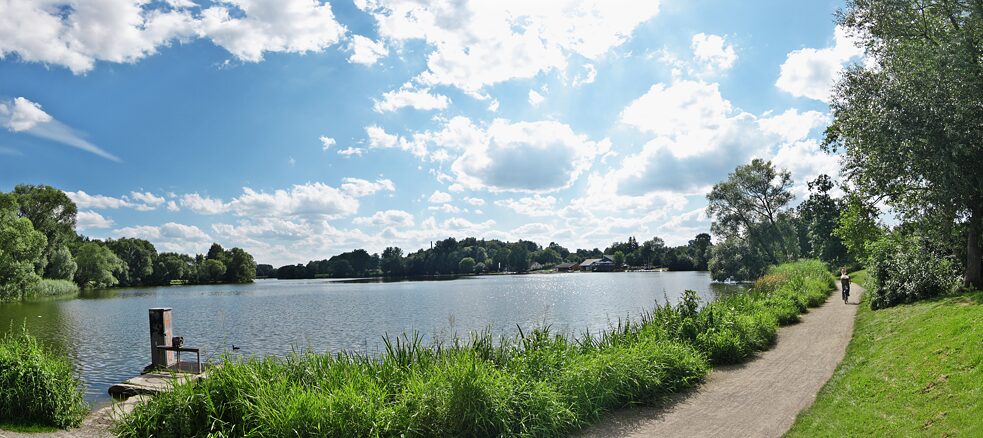 Kiessee has always been a popular and conveniently close lake to visit.
| Photo (detail): © Adobe
A walk along the Wall or ramparts is an excellent hangover cure for the morning after. This green oasis created on top of an old Medieval fortress encircles the entire city centre. It is an excellent route for a tour of historic Gottingen and takes you past the Deutsches Theatre, the Stadthalle concert hall, Cheltenham Park, the old Löhmühle mill, Groner Gate and, last but not least, the Botanical Gardens. In good weather, the Botanical Gardens with their historic greenhouses is one of the most beautiful and quietest places in the city. You’ll need to look carefully for the entrance tucked away between the wall at Nikolausberger Weg and the ramparts, but it is well worth it. Not least because a visit is the perfect excuse to stock up on original Göttinger gin made using herbs grown in the gardens. If your mood is better suited to a relaxing day outside the city proper, head south to the Göttiger Kiessee, a popular gravel-pit lake conveniently close to the city. Get some exercise in the fresh air, explore the lake by row or pedal boat, or just get comfy on a blanket on the shore.
Kiessee has always been a popular and conveniently close lake to visit.
| Photo (detail): © Adobe
A walk along the Wall or ramparts is an excellent hangover cure for the morning after. This green oasis created on top of an old Medieval fortress encircles the entire city centre. It is an excellent route for a tour of historic Gottingen and takes you past the Deutsches Theatre, the Stadthalle concert hall, Cheltenham Park, the old Löhmühle mill, Groner Gate and, last but not least, the Botanical Gardens. In good weather, the Botanical Gardens with their historic greenhouses is one of the most beautiful and quietest places in the city. You’ll need to look carefully for the entrance tucked away between the wall at Nikolausberger Weg and the ramparts, but it is well worth it. Not least because a visit is the perfect excuse to stock up on original Göttinger gin made using herbs grown in the gardens. If your mood is better suited to a relaxing day outside the city proper, head south to the Göttiger Kiessee, a popular gravel-pit lake conveniently close to the city. Get some exercise in the fresh air, explore the lake by row or pedal boat, or just get comfy on a blanket on the shore.
Gottingen’s Händel renaissance
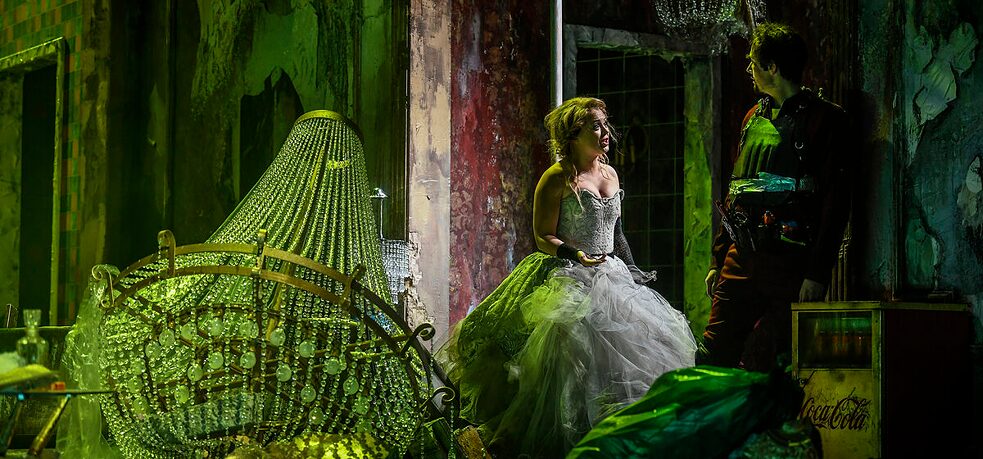 Performance of Georg Friedrich Händel’s opera “Rodrigo” at the 2019 Händel Festival.
| Photo (detail): © Alciro Theodoro da Silva / Internationale Händelfestspiele
Art and culture also have their place in this academic town. Such as every May when the Göttiger Handel Festival takes place. Handel is the featured artist not only because the Baroque composer lived here, but more importantly because his work – more specifically his pieces for the stage – underwent an artistic revival here. For around 200 years, the operas written by Georg Friedrich Handel languished in oblivion until the 1920 production of Rodelinde in Gottingen. The production was so successful that it went on to be performed around 100 more times on other German stages. Today, Handel has become one of the most frequently played opera composers from the Baroque Era. The university, of course, covers a whole range of more eclectic cultural events. In May as well, professors from across all departments DJ at a variety of locations. Profs@Turntables is the ideal opportunity to move from place to place and explore the city’s club scene. ThOP, short for theatre in the OP, is a stage with a unique flair. An acting troupe puts on up to 12 individual productions in an old operating theatre, making it the largest university theatre in Germany.
Performance of Georg Friedrich Händel’s opera “Rodrigo” at the 2019 Händel Festival.
| Photo (detail): © Alciro Theodoro da Silva / Internationale Händelfestspiele
Art and culture also have their place in this academic town. Such as every May when the Göttiger Handel Festival takes place. Handel is the featured artist not only because the Baroque composer lived here, but more importantly because his work – more specifically his pieces for the stage – underwent an artistic revival here. For around 200 years, the operas written by Georg Friedrich Handel languished in oblivion until the 1920 production of Rodelinde in Gottingen. The production was so successful that it went on to be performed around 100 more times on other German stages. Today, Handel has become one of the most frequently played opera composers from the Baroque Era. The university, of course, covers a whole range of more eclectic cultural events. In May as well, professors from across all departments DJ at a variety of locations. Profs@Turntables is the ideal opportunity to move from place to place and explore the city’s club scene. ThOP, short for theatre in the OP, is a stage with a unique flair. An acting troupe puts on up to 12 individual productions in an old operating theatre, making it the largest university theatre in Germany.
Feuerzangenbowle at the Nikolaus party
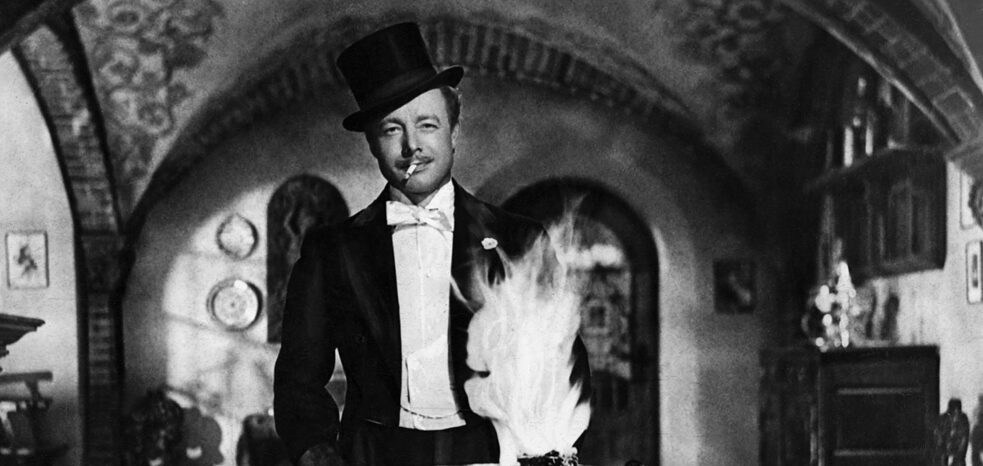 Care for a “tiny sip” of blueberry wine? At the Nikolaus Party in the central lecture hall building around 8,000 attendees celebrate a screening of Heinz Rühmann’s classic “Feuerzangenbowle”.
| Photo (detail): © picture alliance / United Archives | United Archives/Impress
The start of December marks one of the most festive seasons in Gottingen when the quaint Christmas market goes up in the historic town centre. The booths behind the old town hall are particularly cosy and visitors can stand on bark mulch drinking real mulled wine complete with the almost legendary rum cherries at bar tables. Former Gottingen residents return to the city from all corners of Germany for a few days just to hang out at the Christmas market. Then there is the St. Nicholas party in the ZHG. On a Saturday close to St. Nicholas’ Day, December 6, one of the city’s most infamous events takes place in the university’s central lecture hall building. Around 8,000 people attend every year to watch as the evening kicks off with a traditional screening of the Heinz Rührmann classic film Feuerzangenbowle. But beware: cinema here is interactive including props of all kinds, most importantly sparklers, bells and schnapps sipped from lab beakers. Newcomers quickly catch on what to use when and will raise their beakers and join in the hearty toast when the on-screen student in chemistry class is offered just “einen wönzigen Schlock” (a tiny sip) of blueberry wine. And even the Gottingen Symphony Orchestra plays at the party that follows, challenging listeners to join in the Radetzky March or a can-can. If you can’t get to Gottingen in the run-up to Christmas, you can still take part in the “24 experiments until Christmas” online Advent calendar where a new, try-this-at-home physics experiment is revealed every day.
Care for a “tiny sip” of blueberry wine? At the Nikolaus Party in the central lecture hall building around 8,000 attendees celebrate a screening of Heinz Rühmann’s classic “Feuerzangenbowle”.
| Photo (detail): © picture alliance / United Archives | United Archives/Impress
The start of December marks one of the most festive seasons in Gottingen when the quaint Christmas market goes up in the historic town centre. The booths behind the old town hall are particularly cosy and visitors can stand on bark mulch drinking real mulled wine complete with the almost legendary rum cherries at bar tables. Former Gottingen residents return to the city from all corners of Germany for a few days just to hang out at the Christmas market. Then there is the St. Nicholas party in the ZHG. On a Saturday close to St. Nicholas’ Day, December 6, one of the city’s most infamous events takes place in the university’s central lecture hall building. Around 8,000 people attend every year to watch as the evening kicks off with a traditional screening of the Heinz Rührmann classic film Feuerzangenbowle. But beware: cinema here is interactive including props of all kinds, most importantly sparklers, bells and schnapps sipped from lab beakers. Newcomers quickly catch on what to use when and will raise their beakers and join in the hearty toast when the on-screen student in chemistry class is offered just “einen wönzigen Schlock” (a tiny sip) of blueberry wine. And even the Gottingen Symphony Orchestra plays at the party that follows, challenging listeners to join in the Radetzky March or a can-can. If you can’t get to Gottingen in the run-up to Christmas, you can still take part in the “24 experiments until Christmas” online Advent calendar where a new, try-this-at-home physics experiment is revealed every day.
Space walk
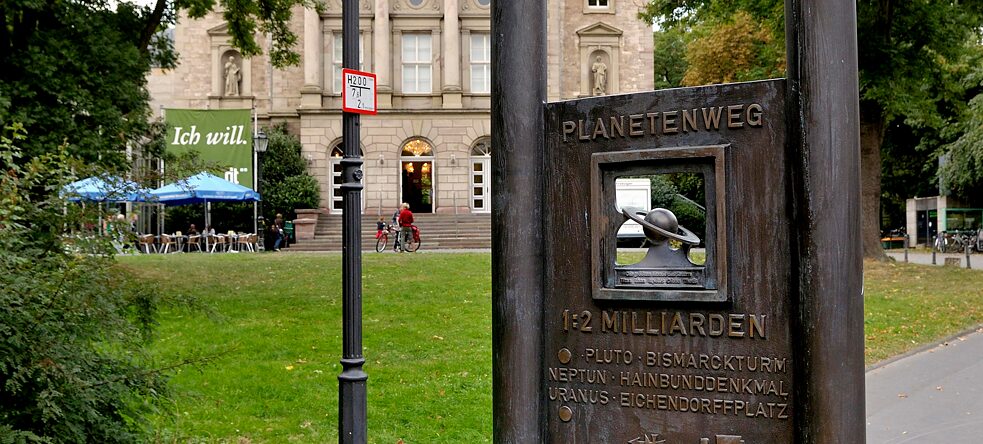 The Planet Path brings the university into Gottingen’s historic city centre.
| Photo (detail): © picture alliance/Kurt Amthor/imageBROKER
You can literally reach for the stars in Gottingen – but best try it during the day. If you walk straight from the train station towards downtown, you will find yourself on Planet Path right across the street. The eight planets of the solar system are represented true to scale on bronze cylinders here. While the Earth is just 6.5 millimetres wide, the sun is an impressive 70 centimetres. One kilometre along the Plant Path translates into two billion kilometres in space. Start with the sun on the corner of Goethealle/Untere-Masch-Straße and for the best round-the-solar-system experience, walk to Saturn on Theaterplatz, then follow the path along the rampart to Neptune at Bismarck Tower. Even Pluto has a spot next to the Max Planck Institute for Solar System Research. The dwarf planet is around six kilometres from the centre of the solar system in Goetheallee.
The Planet Path brings the university into Gottingen’s historic city centre.
| Photo (detail): © picture alliance/Kurt Amthor/imageBROKER
You can literally reach for the stars in Gottingen – but best try it during the day. If you walk straight from the train station towards downtown, you will find yourself on Planet Path right across the street. The eight planets of the solar system are represented true to scale on bronze cylinders here. While the Earth is just 6.5 millimetres wide, the sun is an impressive 70 centimetres. One kilometre along the Plant Path translates into two billion kilometres in space. Start with the sun on the corner of Goethealle/Untere-Masch-Straße and for the best round-the-solar-system experience, walk to Saturn on Theaterplatz, then follow the path along the rampart to Neptune at Bismarck Tower. Even Pluto has a spot next to the Max Planck Institute for Solar System Research. The dwarf planet is around six kilometres from the centre of the solar system in Goetheallee.
Literature in the autumn
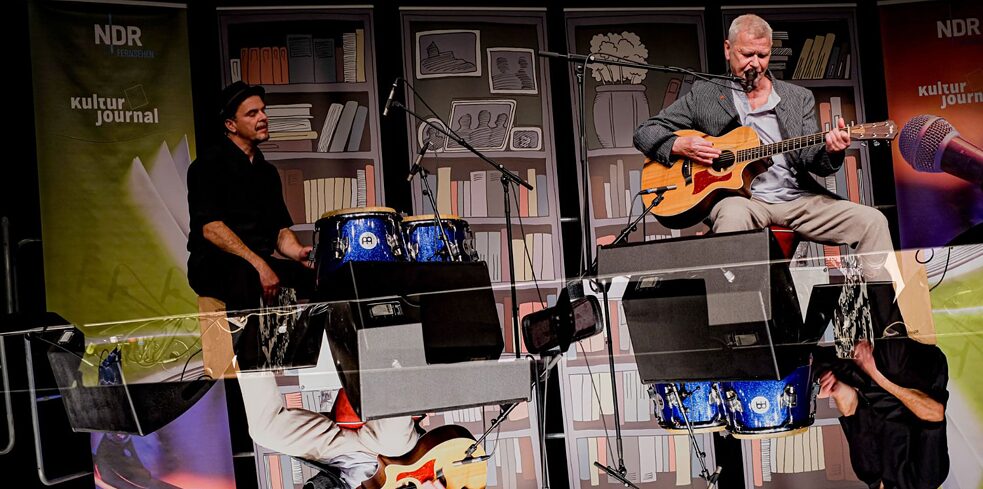 Musician Achim Reichel at Literaturherbst 2020.
| Photo (detail): © Göttinger Literaturherbst
When writers Max Goldt and Doris Dörrie read at the initial Literaturherbst Festival in Gottingen in 1992, they probably had no idea they were at the first event in a decades-long tradition. What started with a reading series of mostly German authors featured the first international authors the following year. Since 1997, Literaturherbst has been organized as a ten-day festival that drew almost 20,000 visitors in 2019. The readings by authors of modern literature – both fiction and non-fiction – take place at different historical locations in Gottingen and are accompanied by performances, music, and intermedia installations. Since 2007, the festival has also included an academic series of talks. The Max Planck Institutes has joined with the Göttingen Literary Autumn Festival to award the Science Communication Medal to scientists who have distinguished themselves in effectively communicating findings to the public.
Musician Achim Reichel at Literaturherbst 2020.
| Photo (detail): © Göttinger Literaturherbst
When writers Max Goldt and Doris Dörrie read at the initial Literaturherbst Festival in Gottingen in 1992, they probably had no idea they were at the first event in a decades-long tradition. What started with a reading series of mostly German authors featured the first international authors the following year. Since 1997, Literaturherbst has been organized as a ten-day festival that drew almost 20,000 visitors in 2019. The readings by authors of modern literature – both fiction and non-fiction – take place at different historical locations in Gottingen and are accompanied by performances, music, and intermedia installations. Since 2007, the festival has also included an academic series of talks. The Max Planck Institutes has joined with the Göttingen Literary Autumn Festival to award the Science Communication Medal to scientists who have distinguished themselves in effectively communicating findings to the public.
Can you decode it?
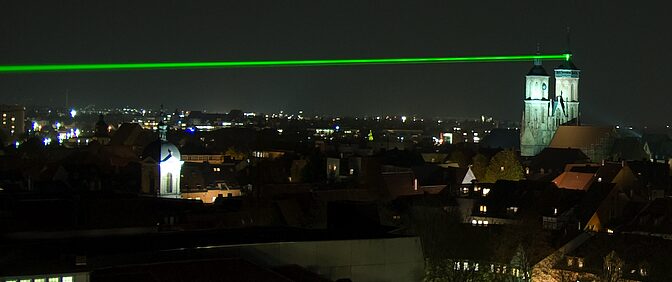 Every night a laser beam serves as a reminder of the path traced by the Gauss-Weber telegraph, the first electromagnetic needle telegraph, and transmits a coded message.
| Photo (detail): © Wolfgang Beisert
Many Gottingen residents and visitors have probably noticed the green laser beam glowing in the night sky late of an evening. Few probably know the secret behind it though. Every month the beam sends a new, coded message in honour of the Gauss-Weber telegraph, the first electromagnetic data line Carl Friedrich Gauss and Wilhelm Weber successfully used to transmit messages via copper wire in 1833. To this day, fax and IM technology and GPS positioning use this technology. For two hours every evening, the laser beam is sent from the old observatory across the city to St. John’s Church starting two hours after sunset. Every month a new message in Gauss-Weber code (a precursor of Morse code) is written in the sky using light signals. If you’d like to read the sky message, you can learn about the code online and see the solutions for the past months’ messages.
Every night a laser beam serves as a reminder of the path traced by the Gauss-Weber telegraph, the first electromagnetic needle telegraph, and transmits a coded message.
| Photo (detail): © Wolfgang Beisert
Many Gottingen residents and visitors have probably noticed the green laser beam glowing in the night sky late of an evening. Few probably know the secret behind it though. Every month the beam sends a new, coded message in honour of the Gauss-Weber telegraph, the first electromagnetic data line Carl Friedrich Gauss and Wilhelm Weber successfully used to transmit messages via copper wire in 1833. To this day, fax and IM technology and GPS positioning use this technology. For two hours every evening, the laser beam is sent from the old observatory across the city to St. John’s Church starting two hours after sunset. Every month a new message in Gauss-Weber code (a precursor of Morse code) is written in the sky using light signals. If you’d like to read the sky message, you can learn about the code online and see the solutions for the past months’ messages.